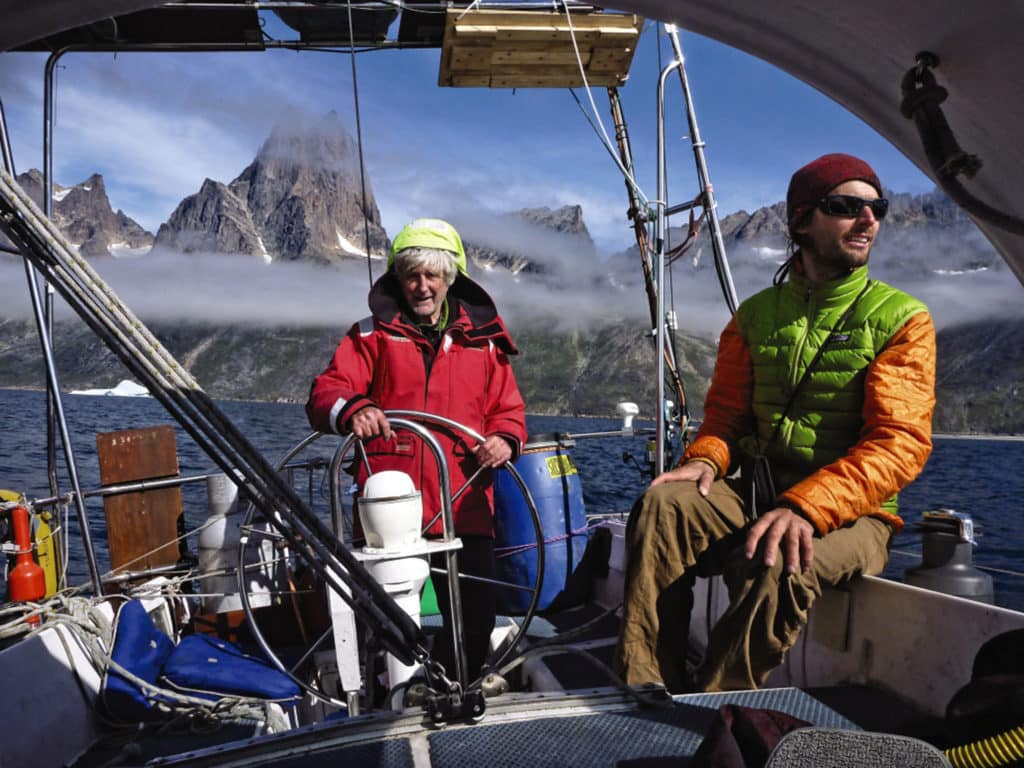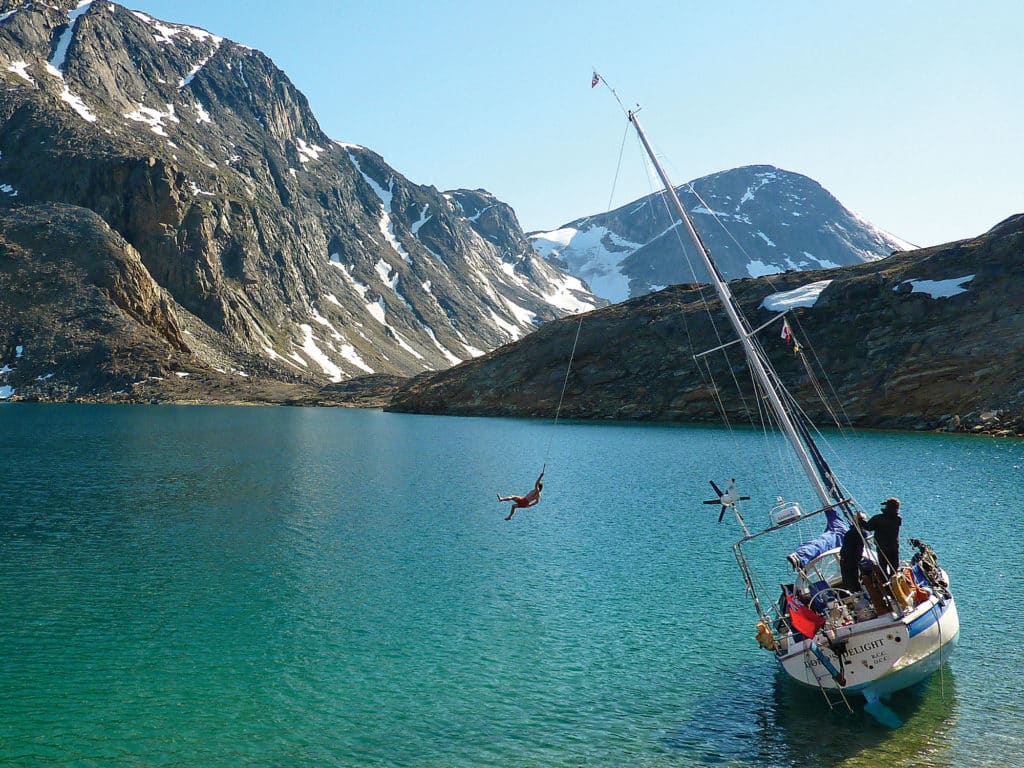
Bob Shepton skied in the darkness, down a Greenland fjord that he’d sailed up only a month before. It was January 2005, and he was overwintering his Westerly 33, Dodo’s Delight, just outside Upernavik, a settlement so far north that there was only a blush of dusk at local noon. “Must fill the diesel heater,” he thought to himself when he reached his icebound boat. He walked along the deck, removed the plug, and began to pour. Almost instantly, red flames leapt from below. Something had gone terribly wrong.
A single thought blared in his mind: I’ve got to put out this fire. He jumped down onto the ice and began scraping up snow with a bucket and dumping it into the saloon. But the fire quickly took hold, driving him off. All he could do was watch as Dodo’s Delight burned through the ice.
A Sailor in the Mountains
“One day I’ll sail for pleasure,” Shepton joked when I met him at the Banff Centre Film and Book Festival. He was giving a presentation about his high-latitude climbing and sailing adventures, much of which are recounted in his memoir, Addicted to Adventure: Between Rocks and Cold Places.
“I’m having a terrible time trying to fit 80-plus years of life and adventures into 35 minutes,” Shepton told me while preparing for the presentation. The 85-year-old has sailed over 130,000 miles, circumnavigated, sailed in every latitude from the Arctic to Antarctica, and twice transited the Northwest Passage—the latter for which he was awarded Britain’s YJA Apollo Yachtsman of the Year in 2013 (Sir Ben Ainslie and Sir Robin Knox-Johnston were the 2012 and 2014 winners). Feats, made all the more incredible, considering he accomplished them in retirement and didn’t start sailing until the age of 43.
Sailing, however, is just half the story. Shepton is also an accomplished climber and has scaled many previously unclimbed Arctic peaks. His adventures have been documented in films such as Vertical Sailing Greenland and The Adventures of the Dodo, and earned him legendary status in the climbing community as well as a Piolet d’Or, one of climbing’s highest honors.
It’s no surprise that he’s also a two-time winner of the Royal Cruising Club’s Tilman Medal and often compared to its namesake, Bill Tilman, an adventurer who gained legendary status by sailing and climbing in some of the world’s most extreme and remote places.
Being a sailor in a sea of puffy jackets and beanies (the Banff Festival is an international mecca for mountain folk), I was excited to sit down with Shepton after his presentation and chat sailing. We convened over coffee in the cabin of Elsie, a 10-meter fish-boat-cum-artist-studio, permanently moored in the middle of the woods at the Banff Centre.
A Higher Calling
Shepton spent much of his early life in search of high places. “The Royal Marines instilled in me a passion for rock climbing,” he said. He went on to spend much of his time developing climbing routes on the south coast of England in the 1960s and ’70s, and trained as a mountaineer and ski instructor.
After two years of service, Shepton studied theology at Cambridge University. In his memoir, he describes his decision to become ordained: “Immediately before I began my final year, I received what I felt was a definite call to be ordained as a ‘pastor and teacher.’ I have always been grateful for these definite callings, as in another sense I was not a ‘natural.’”
Shepton interwove climbing with his work as a school chaplain, at times with unconventional results. He would often take students out climbing and skiing, and wasn’t opposed to using his rope skills to underscore a point in a sermon. One Sunday, he climbed up into the church rafters during a service, and fell (with a rope) as an example of faith. “I found [climbing and mountaineering] great complements to being a chaplain at a school and running full-time youth clubs. It helped them know me and me know them,” he said.
Shepton came to sailing later in life, while looking for a family activity. At 43, he bought his first boat, Faraway, an old pilot cutter for a World War II battleship that had been converted into a gaff-rigged ketch. “This was the first boat we owned on the west coast of Scotland. There were no sailing courses in those days. You just got out there and did it.”
Shepton’s second boat was a Westerly 33. “When I went back down south and became chaplain of another school, we sold the house in Scotland and bought the boat instead—a very unwise decision!” He outfitted the boat with a solid fiberglass cuddy and spray hood and later an inner forestay with roller reefing. “Otherwise it was an ordinary production 33-foot boat. That’s what we’ve done the expeditions in.”
The first significant expedition was across the Atlantic and back. “My wife at this stage was heard to remark, ‘Well that’s all I possess there, going away.’ She was talking about the boat, not me.”
In Tilman’s Wake
“My mentor with all this Arctic sailing was this guy Bill Tilman,” he said. “Tilman was a Himalayan climber before and after World War II, and toward the end of his life, he bought an old Bristol pilot cutter that he used to sail off to remote areas and climb from the boat.” Shepton knew that it would take three to four months just to reach Antarctica and then three months back again, so when he read about Tilman sailing to Greenland, climbing and returning in the same summer, he was hooked on the idea.
He began spending summers in Greenland, sailing 15 to 18 days across the Atlantic to Paamiut, and then up the west coast of Greenland, climbing along the way. “At that stage, it was mainly peak bagging,” he said, “because there were a lot of peaks that hadn’t been climbed.” After a while, Shepton began leaving the boat in Greenland over the winter.

In 2012, at the age of 77, Shepton transited the Northwest Passage from east to west, and then again the following year from west to east. “Some people asked, ‘Well, why would you go back to do it again the next year?’ But you’ve got to remember, it’s a long way down to get to the west coast to Scotland. And there was this terrible rumor that if you went down to the Panama Canal that you might have to pay!”
Shepton estimates there was nearly 60 percent more ice in the Arctic on the return journey. “When we got to Fort Ross, an old Hudson Bay trading post, there was this Damocles of ice all the way down the Prince Regent Inlet. We were effectively stuck. It was now into September, and we were getting a little bit concerned as to whether we were going to be able to get out.
“At first I didn’t understand what was happening. One hears all about global warming, but somehow the fjords seemed much fuller with ice than they did before. I learned that [with warming temperatures], the glaciers are calving more rapidly, more frequently, so the fjords have a lot more ice in them.”
Fortunately, Dodo’s Delight made it through the Northwest Passage that year, though few other boats did.
Fire and Ice
Perhaps one of the greatest trials the reverend has faced to date was in 2005 when, while overwintering in Greenland, Dodo’s Delight burned through the ice. Shepton was taken out that night via snowmobile by the Upernavik Fire Service but returned the next morning to survey the wreckage: one-third of the mast sticking out of the ice and a few scattered cannisters and fenders he’d managed to pull from the burning boat. “I was left standing in what I was wearing at the time,” he said (they were borrowed clothes). “Fortunately, the Danes were very helpful and were able to procure me a passport, and my wife sent some money to a bank account to get me through the winter and bring me back home again.”
For many cruisers, such an episode would have marked the end of their adventures. But not so for Shepton. “When I started to look around for another boat, I came very quickly to the conclusion that I couldn’t do much better than what I had already. So, I looked for and found another Westerly 33.”
When asked why he does what he does, Shepton explained: “It’s always been the challenge aspect that has been the main motive, and that involves achieving the end that you’ve set in sight. That’s not to say that I don’t enjoy the sailing—I do thoroughly enjoy the sailing—but the sailing is in that sense not the main purpose. The main purpose is to get there and to achieve your objective (which usually involves a bit of climbing). So yes, the sailing is great, I enjoy that, but the challenge of achieving your objective is the main motivation.”
When I asked him about future plans, he mentioned an expedition to Norway (he acts as an Arctic adviser, ice pilot and skipper to sailing expeditions). He also hinted at the possibility of another book. “Addicted to Adventure ended with the first Northwest Passage transit,” Shepton said. “When I get really old and decrepit, I will sit down and write another book. I’ve got enough material.”
Fiona McGlynn is a freelance writer and runs waterbornemag.com, a website devoted to millennial sailing culture.








